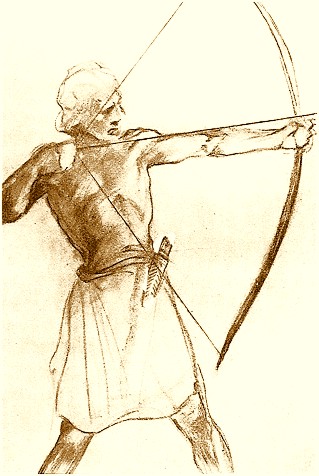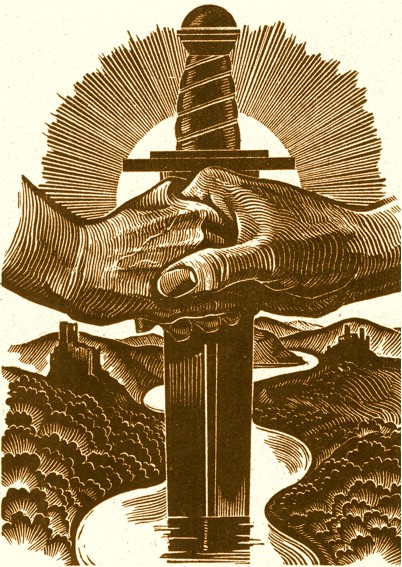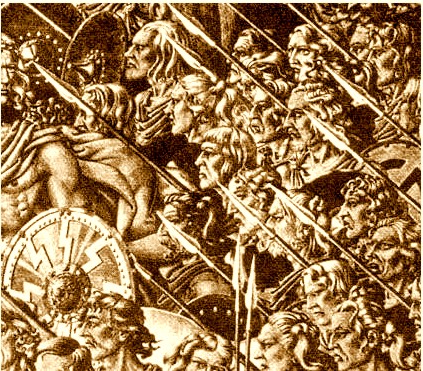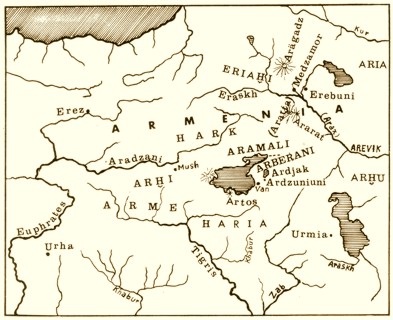![]()
![]()

THE MONARCHY: FROM THE BEGINNING TO THE END
THE HIGH-PRIEST KINGS AND
THE WARRIOR ARISTOCRACY

INTRODUCTION
Written by Gevork Nazaryan
One of the greatest heroic Epics of the Armenian people is the great Cosmic Epic of Hayk -- the Forefather and establisher of the first Armenian Kingdom of AR-MANIA in third millennium BC. The Epic was written down by Mowses Xorēnac‛i -- the father of Armenian History. Xorēnac‛i, wrote down the epic in his History of Armenia in the fifth century, from the oral tradition of the ancient troubadours. The epic story tells us of Hayk [ORION], the leader of the nation of Armens (Armans or Armins) of the original Indo-European Homeland [where the solar cult of Orion originated and spread throughout the world], in the impregnable Highlands of AR-Men-ia. The warrior-king organizes the Armens against the invading forces of the tyrant Bel (Baal) of Babylon attacking from south, from Mesopotamia into the highlands of ARARAT. The Great Armenian Calendar records -- August 11, 2492 BC -- as the day of the cosmic battle [August 11 = the day of the solar eclipse... the light...after...darkness] between the forces of the freedom loving Ar-Men and the invading forces of Bel [in fact of the same divine Arman/Netjeru bloodline...the ShinAr/Chaldean High-priest leaders were the enlightened rulers of Near East as far back as we have records and no doubt before that, the exalted civilization and influence extending to our own days...in the epic Bell is not hard on Hayk at all calling his 'small brother' to return to Babylon as ones Armenic settlers and the Edenic-Elder God culture from the first Neolithic communities brought civilization with the waters of sacred Tigris and Euphrates from the Highland Source...Hayk refuses the big brother...telling Bell to instead RETURN to PARADISE-PARTEZ in peace and love...not in arms...connoting the underlying Stellar and Cyclical significance of the great Epic].

THE ARCHER BY G. XANJEAN [FROM THE HISTORIC TRIPTYCH].
ARCHETYPE OF H A Y K N A H A P E T. THE NATIONAL HERO
WHO CHAMPIONS THE FIGHT OF HIS PEOPLE AGAINST
OVERWHELMING ODDS OF FOREIGN TYRANNY.
Hail to the Dawn, Hail to the Dawn
Hail to the Rising Sun!
May the Sun give plenty of Life to Our King,
Vahé, Vahé...
Hail to the Dawn, Hail to the Dawn
Hail to the Rising Sun!
May the Sun give plenty of Life to Our Queen.
Vahé, Vahé...
-- Ancient folkloric hymn from VAN
A R E G - A K N

[H]AY IN THE SKY

GUARDIANS OF ARMAN HIGH CULTURE.
The decisive battle takes place near the shores of Lake Van. Haik fires a triple headed broad arrow from his long bow directly into the chest of Bel of Babylon. The ample arrow splits the breastplate of Bel, who mortally wounded, falls to the ground. Bels soldiers flee the battlefield after the death of their leader. Haik calls on his kinsmen to unite into one single nation and kingdom in order to defend and continue to cultivate and enrich the ancestral homeland. Haik establishes a settlement -- Haikashēn which becomes the nucleus of the Armenian Kingdom centered around Van-Vaspurakan. Haik places his sons in charge of strategically important areas of Armenia to guard and prevent any further hostilities from foreign incursions into the LAND OF ARARAT [zErikrn Hayoc‛ Araraday].
O R I O N

Hayk, thought by some scholars to be a mythical Indo-European folk hero, is most probably one of the early leaders who was an Armenic king and was later deified as the supreme embodiment of the virtuous character of the hero king. [C]Haldi [connected with the name Chaldean] -- most probably another name for Hayk -- was the God of War and Victory in the exoteric pantheon of gods of Ararat. [C]Haldi was the supreme deity in the holy triad of the primary [exoteric manifest] Gods in the sacred pantheon of Ararat [the other two being Shivini -- the Sun God -- and -- Teyshub -- the God of Lightning -- all three male gods had their three female counterpart goddesses of Beauty, Fertility and Providence] in the second millennium BC.

Thousands of years later, in the first century AD, another Armenian leader, bearing the sacred name of his kinsmen -- Armen or Ar-Man, known Armin[ius] to the Romans and Herman [German] to the Indo-European Cheruski would lead the renowned contingent of 30,000 Armenian horsemen in Bavaria [to this day a lot of Bavarians have, like in so many places throughout Europe, Armenian blood in their veins] against the Romans annihilating three legions of about 20,000 men under the Roman general Publius Quinctilius Varus

STANDING UP AND DEFENDING THOSE THAT ARE UNABLE TO DEFEND
THEMSELVES
at the battle of Teutoburg Forest, recorded in local Bavarian epics of the Middle Ages stating that they are "highlanders from the mountains of Armenia." It is also important to note here that in Old German the name Ashkenaz was both the name for Armenia and Germany, in the Armenian primary sources Ashkenaz [Koriwn, the disciple of Maštoc‛ for example] is always stated as Ashkenazian gund or Ashkenaz cavalry -- another branch of Armenic [Arman] Indo-Europeans, that later split off were the Scythians who were also called Aškuza [and Ask‛anaz is a common name amongst Armenians to this day]. The Anglo-Saxon Chronicle of the Middle Ages would also recount the ancient story of their ancestors originating from Armenia. Some scholars also pointed out that the name Hayk implies Hayak -- son of [H]AYA [EA -- ĒUT'IWN -- DIVINE ESSENCE].

T H E L A N D
O F A R . THE SACRED HIGHLAND WITH ALL OF THE
INDO-EUROPEAN KINSMEN TRIBES WITH AR-HAR-UR-ER-IR-OR VARIATION
PREFIXES DENOTING THEIR COMMON ORIGIN AND KINSHIP
The ancient Armenian word for King -- ARKA -- is synonymous with
-- AREGAK -- SUN -- with the sacred AR root. AR-MAN the name the primordial
ancestor seers called themselves meant MEN of AR. The word Ar-Ar-ich [Creator]
also referred to the celestial Sun [as the cosmic Solar eternal masculine force of creation and
sustenance of LIFE --
Generation/Regeneration combined with sacred eternal feminine Matrix and the
terrestrial Matter/Mother Earth], with the double AR signifying Unity or the Totality
[the Whole] of plurality [which are simply different parts of The One].
![]()
![]()
![]()